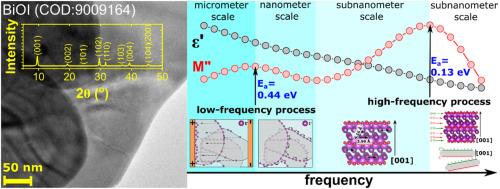从微观到亚纳米尺度:对BiOI纳米板介电性能的洞察
IF 8.2
2区 材料科学
Q1 MATERIALS SCIENCE, MULTIDISCIPLINARY
引用次数: 0
摘要
利用宽带介电光谱研究了在氢氧化钠存在下通过简单水解法制备的超薄团聚型BiOI纳米片在173 ~ 273 K温度范围内的电学性能。所得纳米片的平均厚度为34.8±9.02 nm,尺寸为543.4±103.4 nm,具有氧化卤化铋的无序表面特征,其中Bi(3-x)+是由Bi - o键断裂产生的。光学测量证实直接允许带隙为1.962±0.046 eV,厄巴赫能量为0.0737±0.068 eV。使用Dissado-Hill模型确定并描述了两个主要的电弛豫过程。该高频过程的活化能为0.13±0.01 eV,归因于正电荷[Bi2O2]2+层之间空穴跳变和I -离子迁移的转变。低频过程(低于100 Hz),活化能为0.44±0.02 eV,在高温下出现,并与碘离子沿纳米板表面和边缘迁移,然后在电极界面积聚有关。这些发现表明,层状BiOI纳米板的介电行为是由[Bi2O2]2+层之间的温度和频率相关的碘离子动力学决定的。本文章由计算机程序翻译,如有差异,请以英文原文为准。

From micro to subnano scale: Insights into the dielectric properties of BiOI nanoplates
The electrical properties of ultrathin, agglomerated BiOI nanoplates synthesized via a simple hydrolysis method in the presence of NaOH were investigated over the temperature range of 173–273 K using broadband dielectric spectroscopy. The resulting nanoplates, with an average thickness of 34.8 ± 9.02 nm and size of 543.4 ± 103.4 nm, exhibit disordered surfaces characteristic of bismuth oxyhalides, where Bi(3–x)+ arise from Bi–O bond breaking. Optical measurements confirm a direct allowed band gap of 1.962 ± 0.046 eV and an Urbach energy of 0.0737 ± 0.068 eV. Two dominant electrical relaxation processes were identified and described using the Dissado–Hill model. The high-frequency process, with an activation energy of 0.13 ± 0.01 eV, is attributed to the transition between hole hopping and I− ion migration between positively charged [Bi2O2]2+ layers. The low-frequency process (below 100 Hz), with an activation energy of 0.44 ± 0.02 eV, emerges at elevated temperatures and is associated with iodide ion migration along nanoplate surfaces and edges, followed by their accumulation at the electrode interface. These findings demonstrate that the dielectric behavior of layered BiOI nanoplates is governed by temperature- and frequency-dependent iodide ion dynamics between the [Bi2O2]2+ layers.
求助全文
通过发布文献求助,成功后即可免费获取论文全文。
去求助
来源期刊

Materials Today Nano
Multiple-
CiteScore
11.30
自引率
3.90%
发文量
130
审稿时长
31 days
期刊介绍:
Materials Today Nano is a multidisciplinary journal dedicated to nanoscience and nanotechnology. The journal aims to showcase the latest advances in nanoscience and provide a platform for discussing new concepts and applications. With rigorous peer review, rapid decisions, and high visibility, Materials Today Nano offers authors the opportunity to publish comprehensive articles, short communications, and reviews on a wide range of topics in nanoscience. The editors welcome comprehensive articles, short communications and reviews on topics including but not limited to:
Nanoscale synthesis and assembly
Nanoscale characterization
Nanoscale fabrication
Nanoelectronics and molecular electronics
Nanomedicine
Nanomechanics
Nanosensors
Nanophotonics
Nanocomposites
 求助内容:
求助内容: 应助结果提醒方式:
应助结果提醒方式:


